Double-decker trolley-bus, possibly missing a wire power-pickup or two (cantenery)
The first vehicles advertised by Beeju were in the late 1940's, and there are two distinct periods, the - now warped - cellulose acetate phase and the latter polystyrene range which doesn't suffer from warping. The range included larger vehicles for the American market, ships and boats, novelties like clockwork chicks and TV licenced stuff from Muffin the Mule, but by far the largest part of their oeuvre was the approximately 1:76th scale vehicles, which often have little figures attached.
This particular Trolley-bus has the most people I've ever seen in one of these and is an early, warped version. The model seems to have been dropped from the range before the transition to styrene, however another maker, possibly Portuguese did make stable copies, in brighter colours, without figures, in a styrene plastic.
Here we see a picture previously on my Imageshack account and also shown here before (top right) of the later styrene range mostly in military green, but with a few silver versions, along with several of the earlier vehicles which are all stating to distort. My fire-engine is a bit rough and lacks two firemen and the head of the third!
A lovely metallic-green bus which goes quite well with the military range as a troop-transport. I've seen gold ones, and there are others on the Internet, but this is the only green one I've come across, it's missing it's transfers, which tend to wear-off.
This model was carried over to the stable-material period, where - like the late version lorries - it got a clip-together makeover with locating tabs, instead of the glued components of these earlier types.






4 comments:
The double-decker is appealing to me partly because of the colour and the material used to make it. That vintage look is hard to really replicate with modern materials. Something indefinable is lacking in new pieces.
Nostalgia is a definite factor in all this, you tend to start collecting the bits you had when you were a kid, then you go for the stuff you didn't have but which was around at the time and before you know it your paying attention to both modern issues and stuff from the 1900's!
I like the single-decker, as it reminds me of a couple of early Dinkys that a fighter-pilot neighbour of ours gave us, in the late 60's, which had been his childhood toys.
Technically it's a rural 'coach' - they used to be two-tone and ply the little lane of our green and pleasant land!
Hugh
Hello,
my name is Jorge and i´m a colector of portuguese toys, and i can tell you that the copy´s where made in Portugal by a company named Ribeirinho. This company was founded in 1905, they started to make toys in 1950 till the end of 1979. The first buses have 11 passengers and one driver with metallic colors and painted wheels. Later they where made in bright colors with less passengers, mine has only 3. This company also made small cars copy of Wiking. If you want you can check my blog in mytoycarcollection.blogspot.pt
Cheers
Jorge
Thanks for that Jorge, nice blog, you'll have to post the Beeju copies now you've told us about them!
H
Post a Comment